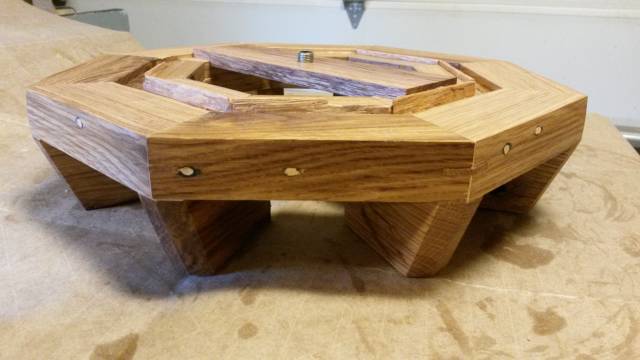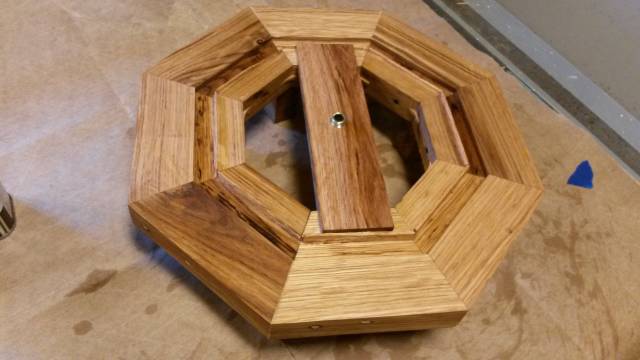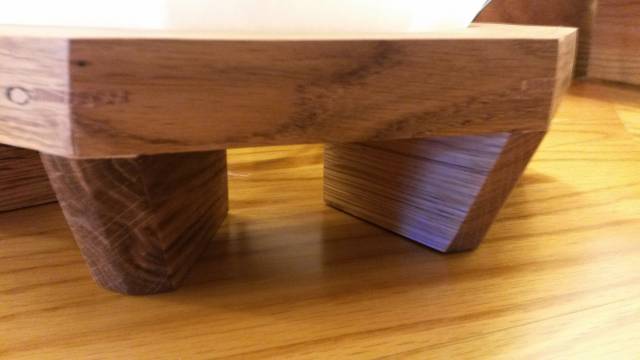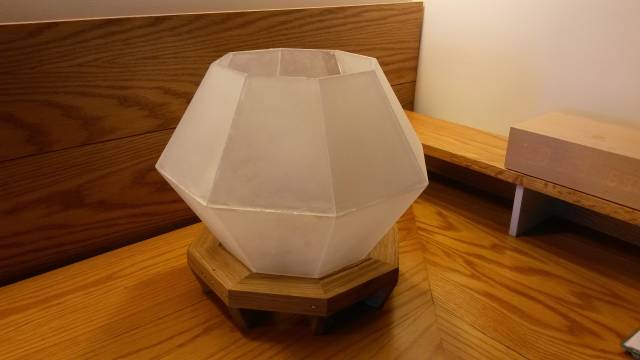7 Comments
Anyway, the base finishing came out nice. I plan to wax it also.




I messed around for a few days trying to make a top section, but in the end I decided that it looks better without anything on top.
I may throw this up on Etsy and see if there’s any interest. Failing that, I guess it will sit on my desk until I decide to turn the lens into a pendant light fixture. We’ll see.
One last thing – this project took about 5 times longer than I anticipated. It was more complex than I originally envisioned. I lost track of the number of hours I put into it but I’m guessing nearly 40 including the plywood prototype. It was fun, but my wife kept beachin’ about not getting any “real” work done in the house. LOL
Losing fingers since 1969
Beautiful Lamp Brian!
You did a great job and explained the process quite nicely.
Abbas, Castro Valley, CA
Nice Lamp Brian, and I like the story that went with it. I have never worked with acrylic before but I thought maybe med. viscosity C.A. glue would also work. Furniture maker Paul Schurch told me he used polyurethane glue to glue veneer to acrylic(might be a bit messy for this type of work).Just a couple other glue options to try if you ever work with it again,not that I know they would work any better. The pallet wood looks great also. I like this type of post because it gets me thinking of cool things to try that are a little outside the box so to speak.
-- Paul--- Creativity is allowing yourself to make mistakes. Art is knowing which ones to keep. — Scott Adams
I am reading your post again Brian now that I got some quiet time to myself.
The frosting of the acrylic is something new to me. That give it a lot of character.
Thanks!
Abbas, Castro Valley, CA
Ian the sanding works great. I did that on my cabinet doors bit only one side was sanded so the outside was still smooth. Believe it or not, as easy as it is to scratch, it doesn’t sand easily. I used 80 grit to get a nice frosted look. Only do this with a ROS or you’ll get streaking.
Tinman, I did some reading before I started about how to join acrylic, which is plastic. Acrylic cement is basically acetone which slightly melts the material and methyl ethyl ketone which bonds the molecules. It’s literally welding. Anything else won’t work. However, many types of glues contain both of these, including CA glue and PVC pipe cement. Those things also have other fillers for different purposes. I used PVC pipe cement for a few reasons. I have it on a shelf already and I didn’t want to buy something new. Secondly, it contains fillers that thicken it. That helps it get into the crevasses of the cut, which was far from smooth on a table saw. I watched some videos about acrylic cement and it’s very watery. You apply it with a syringe along the joint and it gets sucked in to the joint. That can only happen with a very fine edge (tight joint). Slopping PVC cement around wasn’t a problem for me because I wasn’t trying to maintain a perfect clear finish. The opposite, in fact and any run out could be sanded out. There is also acrylic weld, where the filler is acrylic. I think it comes in a tube but I made my own using shavings left on the table saw. Be careful with that. Any sawdust or other debris in the shavings you scoop up can ruin your finish – make it look dirty.
Losing fingers since 1969
Great job Brian! Looks awesome. I know you said you were extra careful there with the dado set and no throat plate, but jeez is that scary looking…
This is a very cool design and super tutorial,outstanding build.
woodworking classes, custom furniture maker













